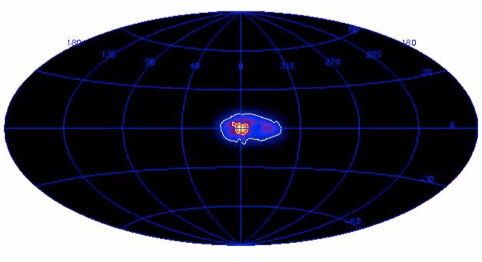Antimatter in the Galaxy - Positron Astrophysics
• What is the source of the Galactic positrons?
• What is the morphology of the diffuse emission?
• What is the role played by dark matter annihilation?
The recent INTEGRAL/SPI all-sky map of the galactic positron annihilation radiation (below) shows emission strongly concentrated in the Galactic Bulge but with evidence of a significant disk asymmetry (Weidenspointner et al. 2008). This bright, diffuse emission exhibits an angular distribution that defies a simple explanation. Its Bulge-Disk line flux ratio is unexpectedly large, and the asymmetry suggests that the bulk of the positrons may originate from a population of low-mass X-ray binaries (LMXBs), and to a lesser extent from radioactive materials injected into the ISM by massive stars. A contribution from dark matter is also possible for the bright central component of the emission. Understanding the origin of positrons in the Galaxy is a frontier question of observational high-energy astrophysics. The signal is very strong, but significant technological advances are still needed to make progress on this question, which can only be addressed with sensitive, high-resolution (in energy and in angle) data in the MeV band. The LMXB explanation leaves room for a bulge and/or halo component, and flux beyond the inner disk (> 50o) remains unmapped.
Over a 3-year mission, DUAL will map the 0.511-MeV line and its associated positronium continuum (integrated line flux ~10-3 γ cm-2 s-1) with a S/N ratio >100σ. DUAL will image the line emission on the sky with 3.2º angular resolution, and 3.3 keV FWHM (820 km/s rms) spectral resolution. With the combined maps and spectral information, we will investigate the contributing sources and annihilation sites in unprecedented detail. Its superior sensitivity and ability to map large-scale emission, as well as its wider FOV and uniform sky exposure, allow DUAL to make major advances over INTEGRAL for these studies. Revealing the distribution and ultimately the origin of galactic positrons is a primary science goal of DUAL.

The production of positrons and their annihilation in the galactic interstellar medium (ISM) is one of the pioneering topics of γ-ray astronomy. Since the detection of the 0.511-MeV line from the inner Galaxy (Leventhal et al. 1978), despite three decades of subsequent observations, the origin of these positrons still remains a mystery. Some of the positrons are created by β+-decay of radioisotopes produced in SN Ia, but INTEGRAL observations of SN 1006 rule out SN Ia as the sole source of positrons, without determining their actual contribution (Kalemci et al. 2006).
OSSE/CGRO and INTEGRAL observations support a time-invariant emission that features an anomalously large contribution from the galactic bulge/halo (Figure 5), relative to expectations derived from emission tracers at other wavelengths. As it becomes increasingly clear that the emission is brightest in the direction of the galactic center, but that the emission appears truly diffuse (rather than from one or just a few point sources near the galactic center), new ideas are being explored to explain these observations. Potential sources include hypernovae from an episode of starburst activity in the bulge, SN Ia, pulsar winds, annihilation or decay of hypothetical light dark matter particles and micro-quasars. A disk component must be present, as core collapse supernovae (ccSNe) replenish positrons from radioactive ejecta, but is perhaps weaker than expected. This may in part be explained with positron propagation effects in the magnetic fields of a complex, multi-component ISM. Mapping the spatial distribution of the annihilation emission is crucial to understanding the origin of the positrons. DUAL is sensitive to ~0.2 MeV, so that the three-photon positronium (Ps) continuum can be measured and mapped which constrains the conditions of the Galactic multi-component ISM. INTEGRAL/SPI has advanced Galactic positron astrophysics in major ways, but fundamental gaps remain in our understanding of this anti-matter component of our Milky Way.
The strong central distribution of positron emission at the Galactic Center naturally suggests a connection with the expected concentration of dark matter. A wide variety of models based on dark matter annihilation or decay have been explored. It is also worth noting that a variety of dark matter models would lead to the direct production of MeV γ-ray lines, at energies connected to the dark matter mass. With its angular resolution and excellent flux sensitivity, DUAL will be able to clearly measure the morphology of the emission region associated with any such γ-ray lines. This would isolate any exotic contributions associated with dark matter, which would be circularly symmetric around a sharp peak at the Galactic Center, from conventional astrophysical sources, which will follow the shape of the disk and bulge.
